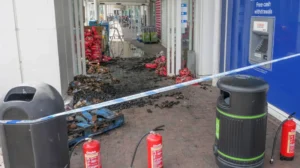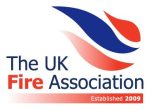You’ve probably walked past dozens of fire doors today — in offices, schools, shops or stairwells.
But what actually makes a fire door different from a regular door? And how can you tell if it’s doing its job?
Let’s take a look at the key components of a fire door in the UK, the standards they need to meet, and what to look out for during checks or inspections.
The Door Leaf
This is the main body of the door and must be certified to resist fire for a set amount of time — typically 30 or 60 minutes (FD30 or FD60 rated).
It should be tested to BS 476 Part 22 or BS EN 1634-1.
You should always check for a certification label, often found on the top or side edge of the door.
If the door is warped, cracked, or damaged, its fire resistance could be compromised.
The Door Frame
Frames should be made from compatible fire-resistant materials and properly fitted to the wall.
The gap between the door and the frame should be consistent and not exceed 3mm at the sides and 4mm at the top.
If the frame is loose or poorly installed, the door may not perform as required in a fire.
Intumescent and Smoke Seals
These seals expand in heat to block the passage of smoke and flames.
They’re usually fitted around the door edge or within the frame.
They must meet BS 476 Part 31.1 and should be intact, clean, and not painted over.
If they’re damaged or missing, they’ll fail in a fire.
Hinges
Fire doors must be hung with at least three steel hinges, all compliant with BS EN 1935 and CE-marked.
Check that all screws are present and secure.
Loose or worn hinges can stop a door from closing properly — a common fault in high-use areas.
Vision Panels (Glazing)
If the door has glass, it must be fire-rated and installed with intumescent glazing seals.
Fire-rated glass is tested to BS EN 14449. Make sure the glass isn’t cracked and that the seals and beading are in place and undamaged.
Self-Closing Device
A fire door must always close itself fully and latch shut.
This is typically achieved with an overhead closer that complies with BS EN 1154.
If the door doesn’t shut on its own, slams too hard, or sticks part-way, the closer may need adjustment or replacement.
Signage
All fire doors should carry correct signage — such as “Fire Door Keep Shut” — in line with BS 5499. Signs should be clearly visible on both sides of the door and firmly attached.
Even minor faults in any of these areas can seriously affect a fire door’s ability to protect life and property.
Common issues we see include doors wedged open, missing seals, large gaps, broken closers, or uncertified installations.
These may seem like small things, but they can have major consequences in a fire.
A compliant fire door is the result of every component working together — from hinges to seals, frames to signage.
They need to be checked regularly (every six months is the general recommendation) and properly maintained, especially in high-use environments.
Why Fire Door Inspections Are So Important
Even a perfectly installed fire door won’t stay compliant forever.
Wear and tear, heavy use, accidental damage, or even small DIY fixes can all affect how a door performs.
That’s why regular inspections are essential — not just for safety, but also for compliance with UK law.
According to the Regulatory Reform (Fire Safety) Order 2005, the responsible person (such as the business owner, landlord or facilities manager) must ensure that all fire safety systems, including fire doors, are maintained in efficient working order.
The recommended inspection standard is BS 9999:2017 – Code of practice for fire safety in the design, management and use of buildings, which advises that fire doors should be checked every six months at a minimum — and more frequently in high-traffic areas like corridors, stairwells or busy communal spaces.
These inspections should include checks of the door leaf, frame, seals, hinges, closer, glazing, signage and gaps — everything needed to confirm that the door is functioning as intended.
A trained fire door inspector will also provide a written report highlighting any faults and the remedial action required.
If a door can’t do its job in a fire, it puts lives at risk — so staying on top of inspections isn’t just good practice.
It’s both a legal and moral responsibility.
At ESI, we carry out professional fire door inspections across Farnborough, Camberley, Aldershot and throughout Surrey, Hampshire and Berkshire. We’ll help you spot faults, stay compliant with UK regulations, and keep your staff and building protected. If you’d like advice or to book an inspection, just get in touch.











